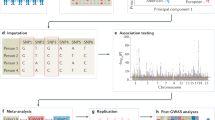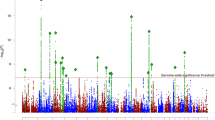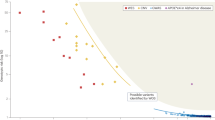Abstract
In an effort to pinpoint potential genetic risk factors for schizophrenia, research groups worldwide have published over 1,000 genetic association studies with largely inconsistent results. To facilitate the interpretation of these findings, we have created a regularly updated online database of all published genetic association studies for schizophrenia ('SzGene'). For all polymorphisms having genotype data available in at least four independent case-control samples, we systematically carried out random-effects meta-analyses using allelic contrasts. Across 118 meta-analyses, a total of 24 genetic variants in 16 different genes (APOE, COMT, DAO, DRD1, DRD2, DRD4, DTNBP1, GABRB2, GRIN2B, HP, IL1B, MTHFR, PLXNA2, SLC6A4, TP53 and TPH1) showed nominally significant effects with average summary odds ratios of ∼1.23. Seven of these variants had not been previously meta-analyzed. According to recently proposed criteria for the assessment of cumulative evidence in genetic association studies, four of the significant results can be characterized as showing 'strong' epidemiological credibility. Our project represents the first comprehensive online resource for systematically synthesized and graded evidence of genetic association studies in schizophrenia. As such, it could serve as a model for field synopses of genetic associations in other common and genetically complex disorders.
This is a preview of subscription content, access via your institution
Access options
Subscribe to this journal
Receive 12 print issues and online access
$209.00 per year
only $17.42 per issue
Buy this article
- Purchase on SpringerLink
- Instant access to full article PDF
Prices may be subject to local taxes which are calculated during checkout
Similar content being viewed by others
References
Mueser, K.T. & McGurk, S.R. Schizophrenia. Lancet 363, 2063–2072 (2004).
Owen, M.J., Craddock, N. & O'Donovan, M.C. Schizophrenia: genes at last? Trends Genet. 21, 518–525 (2005).
Sullivan, P.F., Kendler, K.S. & Neale, M.C. Schizophrenia as a complex trait: evidence from a meta-analysis of twin studies. Arch. Gen. Psychiatry 60, 1187–1192 (2003).
Badner, J.A. & Gershon, E.S. Meta-analysis of whole-genome linkage scans of bipolar disorder and schizophrenia. Mol. Psychiatry 7, 405–411 (2002).
Lewis, C.M. et al. Genome scan meta-analysis of schizophrenia and bipolar disorder, part II: schizophrenia. Am. J. Hum. Genet. 73, 34–48 (2003).
Bertram, L., McQueen, M.B., Mullin, K., Blacker, D. & Tanzi, R.E. Systematic meta-analyses of Alzheimer disease genetic association studies: the AlzGene database. Nat. Genet. 39, 17–23 (2007).
Thakkinstian, A. et al. Systematic review and meta-analysis of the association between complement factor H Y402H polymorphisms and age-related macular degeneration. Hum. Mol. Genet. 15, 2784–2790 (2006).
Ioannidis, J.P., Ntzani, E.E. & Trikalinos, T.A. 'Racial' differences in genetic effects for complex diseases. Nat. Genet. 36, 1312–1318 (2004).
Lange, C., DeMeo, D., Silverman, E.K., Weiss, S.T. & Laird, N.M. PBAT: tools for family-based association studies. Am. J. Hum. Genet. 74, 367–369 (2004).
Ioannidis, J.P. & Trikalinos, T.A. Early extreme contradictory estimates may appear in published research: the Proteus phenomenon in molecular genetics research and randomized trials. J. Clin. Epidemiol. 58, 543–549 (2005).
Li, D. & He, L. Association study between the NMDA receptor 2B subunit gene (GRIN2B) and schizophrenia: a HuGE review and meta-analysis. Genet. Med. 9, 4–8 (2007).
Mah, S. et al. Identification of the semaphorin receptor PLXNA2 as a candidate for susceptibility to schizophrenia. Mol. Psychiatry 11, 471–478 (2006).
Lencz, T. et al. Converging evidence for a pseudoautosomal cytokine receptor gene locus in schizophrenia. Mol. Psychiatry 12, 572–580 (2007).
Fujii, T. et al. Failure to confirm an association between the PLXNA2 gene and schizophrenia in a Japanese population. Prog. Neuropsychopharmacol. Biol. Psychiatry 31, 873–877 (2007).
Ioannidis, J.P. et al. Assessment of cumulative evidence on genetic associations: interim guidelines. Int. J. Epidemiol. 37, 120–132 (2008); published online 26 September 2007.
Ioannidis, J.P. et al. A road map for efficient and reliable human genome epidemiology. Nat. Genet. 38, 3–5 (2006).
Ioannidis, J.P., Ntzani, E.E., Trikalinos, T.A. & Contopoulos-Ioannidis, D.G. Replication validity of genetic association studies. Nat. Genet. 29, 306–309 (2001)
Lohmueller, K.E., Pearce, C.L., Pike, M., Lander, E.S. & Hirschhorn, J.N. Meta-analysis of genetic association studies supports a contribution of common variants to susceptibility to common disease. Nat. Genet. 33, 177–182 (2003).
Wellcome Trust Case Control Consortium. Genome-wide association study of 14,000 cases of seven common diseases and 3,000 shared controls. Nature 447, 661–678 (2007).
Missale, C., Fiorentini, C., Busi, C., Collo, G. & Spano, P.F. The NMDA/D1 receptor complex as a new target in drug development. Curr. Top. Med. Chem. 6, 801–808 (2006).
Tauscher, J. et al. Equivalent occupancy of dopamine D1 and D2 receptors with clozapine: differentiation from other atypical antipsychotics. Am. J. Psychiatry 161, 1620–1625 (2004).
Williams, N.M., O'Donovan, M.C. & Owen, M.J. Is the dysbindin gene (DTNBP1) a susceptibility gene for schizophrenia? Schizophr. Bull. 31, 800–805 (2005).
Weickert, C.S. et al. Human dysbindin (DTNBP1) gene expression in normal brain and in schizophrenic prefrontal cortex and midbrain. Arch. Gen. Psychiatry 61, 544–555 (2004).
Roffman, J.L. et al. Contribution of methylenetetrahydrofolate reductase (MTHFR) polymorphisms to negative symptoms in schizophrenia. Biol. Psychiatry 63, 42–48 (2008).
Frosst, P. et al. A candidate genetic risk factor for vascular disease: a common mutation in methylenetetrahydrofolate reductase. Nat. Genet. 10, 111–113 (1995).
van der Put, N.M. et al. A second common mutation in the methylenetetrahydrofolate reductase gene: an additional risk factor for neural-tube defects? Am. J. Hum. Genet. 62, 1044–1051 (1998)
Munafo, M.R., Thiselton, D.L., Clark, T.G. & Flint, J. Association of the NRG1 gene and schizophrenia: a meta-analysis. Mol. Psychiatry 11, 539–546 (2006).
McGorry, P.D. et al. Spurious precision: procedural validity of diagnostic assessment in psychotic disorders. Am. J. Psychiatry 152, 220–223 (1995).
Wacholder, S., Chanock, S., Garcia-Closas, M., El Ghormli, L. & Rothman, N. Assessing the probability that a positive report is false: an approach for molecular epidemiology studies. J. Natl. Cancer Inst. 96, 434–442 (2004).
Ioannidis, J.P. Why most published research findings are false. PLoS Med. 2, e124 (2005).
Evangelou, E., Maraganore, D.M. & Ioannidis, J.P. Meta-analysis in genome-wide association datasets: strategies and application in Parkinson disease. PLoS ONE 2, e196 (2007).
DerSimonian, R. & Laird, N. Meta-analysis in clinical trials. Control. Clin. Trials 7, 177–188 (1986).
Higgins, J.P. & Thompson, S.G. Quantifying heterogeneity in a meta-analysis. Stat. Med. 21, 1539–1558 (2002).
Higgins, J.P., Thompson, S.G., Deeks, J.J. & Altman, D.G. Measuring inconsistency in meta-analyses. Br. Med. J. 327, 557–560 (2003).
Ioannidis, J.P., Patsopoulos, N. & Evangelou, E. Uncertainty in estimates of heterogeneity in meta-analysis. Br. Med. J. 335, 914–916 (2007).
Egger, M., Davey Smith, G., Schneider, M. & Minder, C. Bias in meta-analysis detected by a simple, graphical test. Br. Med. J. 315, 629–634 (1997).
Harbord, R.M., Egger, M. & Sterne, J.A. A modified test for small-study effects in meta-analyses of controlled trials with binary endpoints. Stat. Med. 25, 3443–3457 (2006).
Lau, J., Ioannidis, J.P., Terrin, N., Schmid, C.H. & Olkin, I. The case of the misleading funnel plot. Br. Med. J. 333, 597–600 (2006).
Ioannidis, J.P. & Trikalinos, T.A. An exploratory test for an excess of significant findings. Clin. Trials 4, 245–253 (2007).
Acknowledgements
Funding for this study was provided by the National Alliance on Research in Schizophrenia and Depression (to L.B.). F.K.K. was supported by a PENED training grant co-financed by E.U. European Social Fund and the Greek Ministry of Development, General Secretariat for Research and Technology. We are grateful to the Schizophrenia Research Forum for hosting SzGene on their website. In particular, we would like to thank A. Bumstead, H. Heimer, C. Knep and P. Noyes for the online adaptation of SzGene and many helpful discussions. We would further like to thank the members of the Scientific Advisory Board (currently including W. Byerly, G.D. Smith, J. Kennedy, D.F. Levinson and M. Owen) for their repeated review of the database and their helpful comments and suggestions during the development of this project.
Author information
Authors and Affiliations
Contributions
This study was designed by L.B. (principal investigator). Literature searches, data entry and online curation of data was done by N.C.A. and S.B., with help from L.B. Analysis scripts were developed and written by M.B.M. and F.K.K., and analyses were done by N.C.A., F.K.K., J.P.A.I. and L.B. The manuscript was written by N.C.A. and L.B., with contributions from J.P.A.I, F.K.K., M.J.K. and R.E.T.
Corresponding author
Supplementary information
Rights and permissions
About this article
Cite this article
Allen, N., Bagade, S., McQueen, M. et al. Systematic meta-analyses and field synopsis of genetic association studies in schizophrenia: the SzGene database. Nat Genet 40, 827–834 (2008). https://doi.org/10.1038/ng.171
Published:
Issue Date:
DOI: https://doi.org/10.1038/ng.171



